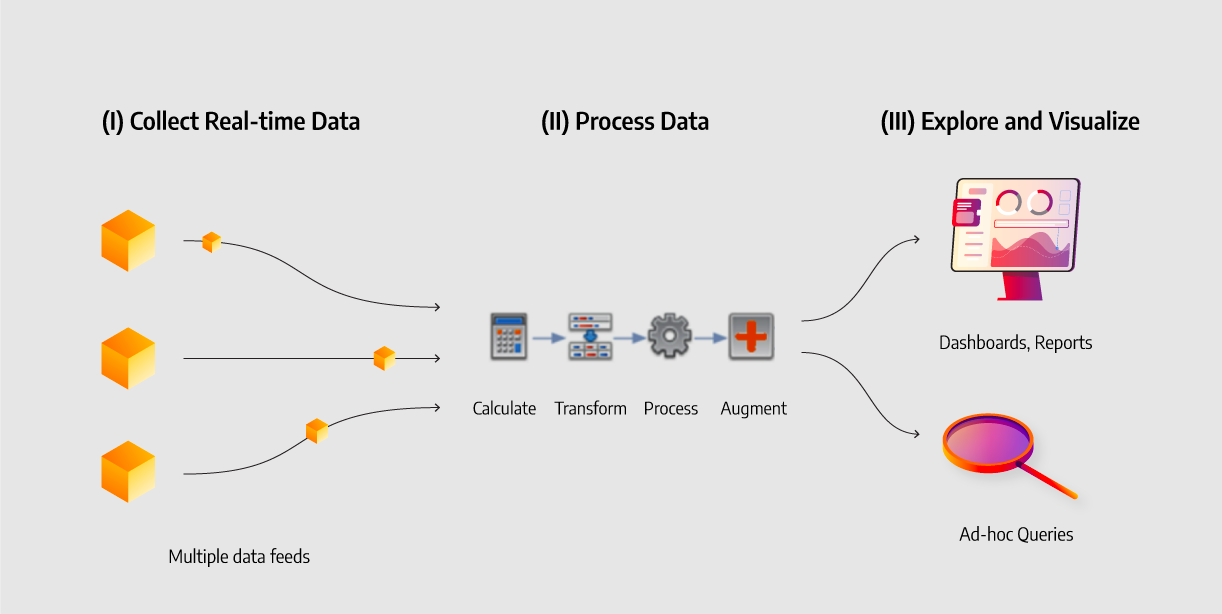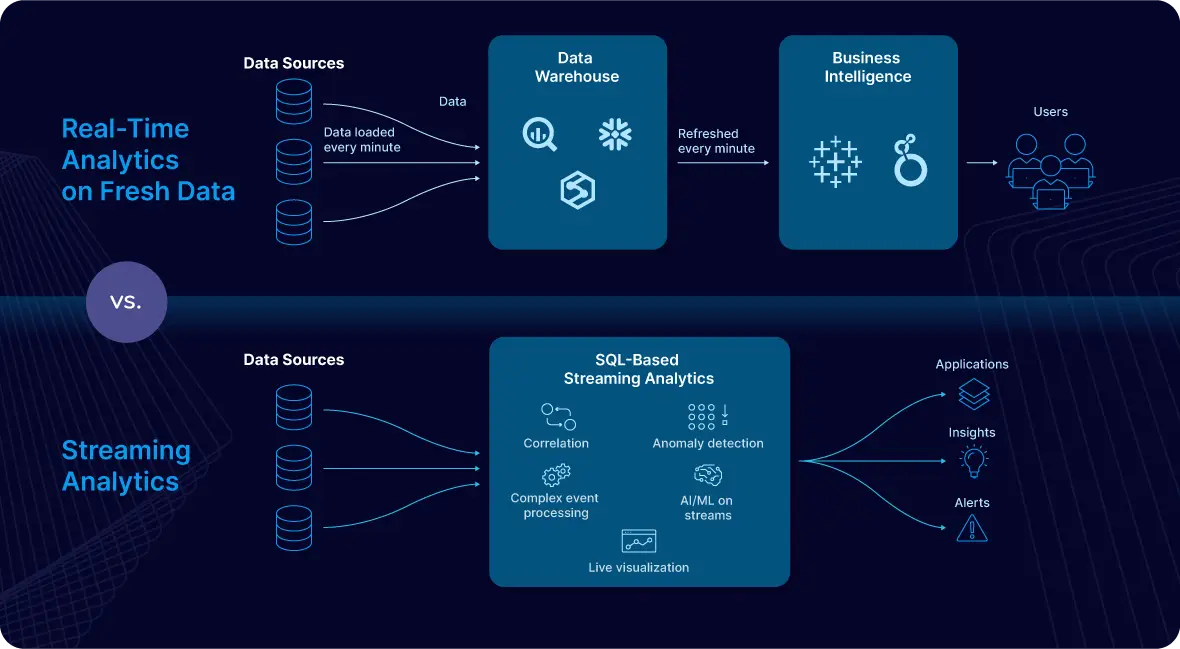Real-time data analytics is transforming how businesses operate today. It offers insights that drive quick, informed decisions.
In a world where data is generated every second, harnessing it effectively is crucial. Real-time data analytics provides the tools to analyze this influx instantly. This approach empowers organizations to act swiftly, adapting strategies in real-time. Imagine understanding customer behavior as it happens, or detecting system anomalies before they escalate. This capability enhances efficiency, improves customer satisfaction, and boosts overall performance. Tools like Blaze streamline this process further, offering AI-driven solutions for seamless content creation and marketing. Explore how Blaze can enhance your real-time data analytics experience by visiting their site here. Discover a smarter way to handle data and stay ahead.
Introduction To Real-time Data Analytics
In today’s digital age, real-time data analytics plays a crucial role. It enables businesses to process and analyze data as it comes in, offering immediate insights. This ability to access instant insights can significantly impact decision-making processes, allowing companies to remain agile and responsive.
Understanding Real-time Data Analytics
Real-time data analytics refers to the immediate processing and analysis of data. This process happens as the data is received, rather than storing it for later examination. It involves the use of advanced technologies to handle large volumes of data at high speeds.
Businesses often use tools like Blaze to streamline their data analytics processes. Blaze provides features such as AI-powered templates and real-time collaboration. These tools enhance the ability to analyze data quickly and efficiently.
The Purpose And Importance Of Instant Insights
Instant insights allow companies to make informed decisions promptly. This capability is vital in industries where time-sensitive decisions are crucial, such as finance and healthcare.
- Time Efficiency: Real-time analytics saves valuable time by providing immediate data interpretations.
- Enhanced Productivity: Teams can focus on strategic tasks rather than waiting for data reports.
- Competitive Advantage: Businesses can stay ahead by responding swiftly to market changes.
Using tools like Blaze, companies can integrate SEO optimization and content scheduling. These features ensure that businesses not only gain insights but also implement strategies effectively.
With real-time data analytics, companies can harness the power of instant insights to drive growth and efficiency. This approach is crucial for maintaining competitiveness in a fast-paced market environment.

Credit: memgraph.com
Key Features Of Real-time Data Analytics
Real-Time Data Analytics is transforming how businesses make decisions. By leveraging its key features, companies can gain insights quickly and efficiently. Understanding these features can help organizations stay ahead in today’s fast-paced world.
Continuous Data Processing
Continuous data processing allows businesses to access and analyze data as it flows. This feature ensures data is constantly updated, providing the most current insights. It helps in identifying trends and patterns, allowing for timely decision-making.
- Data is processed as it arrives, ensuring up-to-date information.
- Helps in tracking real-time events and activities.
- Supports dynamic data environments.
Speed And Responsiveness
Speed and responsiveness are crucial in Real-Time Data Analytics. Quick data processing means faster insights. This feature helps businesses react promptly to changes and opportunities.
- Enables rapid identification of issues and opportunities.
- Improves decision-making speed.
- Supports immediate data-driven actions.
Scalability And Flexibility
Scalability and flexibility ensure the system can handle growing data volumes. As businesses expand, their data needs grow. This feature allows for seamless adjustment without loss of performance.
- Adapts to increasing data demands.
- Supports diverse data types and sources.
- Ensures consistent performance under varying loads.
Blaze, with its Real-Time Collaboration and SEO Optimization, complements these features, offering a comprehensive solution for businesses.
| Feature | Description |
|---|---|
| AI-Powered Templates | Generates content swiftly with minimal input. |
| Full Cycle Marketing | Automatically grows sales through virtual marketing. |
| Real-Time Collaboration | Facilitates team collaboration for content creation. |
Explore how Blaze can enhance your Real-Time Data Analytics efforts by visiting Blaze’s official website.
Benefits Of Real-time Data Analytics
Real-time data analytics transforms how businesses operate. By processing data instantly, it offers numerous benefits that improve efficiency and decision-making. Let’s explore these advantages in detail.
Enhanced Decision-making
Real-time data analytics empowers businesses with immediate insights. This allows leaders to make informed decisions swiftly. For example, access to live data helps businesses adjust strategies promptly. It reduces the lag between data collection and decision-making. This timely access to information ensures that businesses stay ahead of trends. By evaluating data as it flows, companies can optimize their operations and strategies.
Improved Customer Experience
Understanding customer needs in real-time enhances service delivery. Real-time analytics allows businesses to tailor experiences immediately. This personalization fosters stronger relationships with customers. By analyzing customer interactions, businesses can offer targeted solutions. This leads to higher satisfaction and loyalty. Furthermore, quick responses to customer feedback improve brand perception.
Operational Efficiency
Real-time data analytics boosts operational efficiency by monitoring processes continuously. Businesses can identify bottlenecks and inefficiencies instantly. This allows them to implement solutions without delay. A more streamlined operation reduces costs and increases productivity. By leveraging real-time insights, companies can enhance their workflows and resource allocation. This ensures optimal performance across all departments.
Incorporating real-time data analytics into business strategies offers substantial advantages. From improving decision-making to enhancing customer experiences, the benefits are clear. By harnessing this powerful tool, businesses can achieve greater operational efficiency and stay competitive.

Credit: www.striim.com
Challenges And Solutions In Real-time Data Analytics
Real-time data analytics is transforming industries by providing instant insights. Yet, it comes with challenges that can hinder its effectiveness. Identifying and addressing these challenges is crucial for businesses aiming to leverage real-time data. Here, we explore the main challenges and their solutions.
Data Volume And Complexity
Handling vast amounts of data is a significant challenge. Real-time analytics requires processing large volumes quickly. The complexity increases with unstructured data from various sources.
- Solution: Implement scalable data storage solutions.
- Solution: Use advanced algorithms for data filtering and classification.
Scalable solutions ensure efficient data management. Advanced algorithms enhance processing speed and accuracy.
Integration With Existing Systems
Integrating new analytics tools with current systems is often problematic. Compatibility issues can slow down implementation and affect data accuracy.
- Solution: Opt for flexible and compatible analytics platforms.
- Solution: Use middleware for seamless integration.
Flexible platforms and middleware facilitate smooth integration. They ensure that analytics tools work harmoniously with existing infrastructure.
Ensuring Data Quality
Maintaining high data quality is essential for accurate analytics. Real-time data can contain errors, duplicates, or inconsistencies, affecting reliability.
- Solution: Employ real-time data validation techniques.
- Solution: Use AI-powered tools for data cleansing and monitoring.
Real-time validation and AI tools enhance data quality. They help in detecting and correcting errors promptly.
Pricing And Affordability Of Real-time Data Analytics Tools
Real-Time Data Analytics tools have become essential for businesses. They help make quick decisions based on live data. But one major concern is their pricing and affordability. Choosing the right tool requires understanding various cost factors. Comparing popular tools can also help find the best fit.
Cost Factors To Consider
Several cost factors influence the pricing of Real-Time Data Analytics tools:
- Subscription Fees: Monthly or annual fees can vary greatly.
- Feature Access: More features often mean higher costs.
- Customization: Tailoring the tool to your needs may incur extra charges.
- Integration: Costs may rise if tools need integration with other systems.
- Support Services: Premium support can add to expenses.
Understanding these factors can help in budgeting effectively for these tools.
Comparative Analysis Of Popular Tools
Here is a comparison of some popular Real-Time Data Analytics tools:
| Tool Name | Free Trial | Price | Main Features |
|---|---|---|---|
| Blaze | 7-day free trial | Flexible, cancel anytime | AI-powered templates, SEO optimization, multilingual capabilities |
| Tool X | 14-day free trial | Starts at $50/month | Real-time data processing, integration with third-party apps |
| Tool Y | 30-day free trial | Starts at $100/month | Custom dashboards, advanced analytics |
Blaze offers a flexible pricing model with no credit card required for the trial. It also allows cancellation anytime during the trial period. This makes Blaze an attractive option for those exploring Real-Time Data Analytics tools.
Each tool has unique features. It’s important to match them with your business needs for optimal results.

Credit: datahubanalytics.com
Pros And Cons Of Real-time Data Analytics
Real-time data analytics offers businesses immediate insights that can transform decision-making processes. However, like any technology, it presents both benefits and challenges. Understanding these can help businesses leverage its potential effectively.
Advantages Of Immediate Insights
Real-time data analytics provides instant access to valuable information. This enables businesses to respond quickly to market changes. Immediate insights allow for faster decision-making, enhancing operational efficiency. Here are some key advantages:
- Enhanced Decision-Making: Access timely data to make informed choices.
- Improved Customer Experience: Respond swiftly to customer needs and feedback.
- Operational Efficiency: Optimize processes by identifying bottlenecks quickly.
These advantages can give companies a competitive edge, allowing them to stay ahead in dynamic markets.
Potential Drawbacks And Limitations
Despite the benefits, real-time data analytics comes with challenges. The need for high-speed infrastructure can be costly. Data accuracy and reliability issues may arise, impacting decisions. Consider these potential drawbacks:
- High Costs: Investments in technology and infrastructure can be expensive.
- Data Overload: Managing and interpreting vast amounts of data requires expertise.
- Security Risks: Real-time data flow increases vulnerability to cyber threats.
Businesses must weigh these limitations against the benefits to make informed choices about adoption.
For more information on real-time data analytics and its applications, visit Blaze.
Recommendations For Implementing Real-time Data Analytics
Implementing real-time data analytics can transform business operations. By leveraging immediate insights, companies can make informed decisions quickly. This section outlines recommendations for successfully integrating real-time analytics into your workflow.
Ideal Use Cases And Industries
Real-time data analytics is invaluable across various industries. It shines in sectors like finance, where instant data processing can detect fraud swiftly. In healthcare, real-time analytics helps monitor patient vitals, improving response times. Retailers use it for inventory management, ensuring stock levels meet demand instantly. It also benefits logistics, optimizing delivery routes and reducing costs. These are just a few examples where real-time analytics proves essential.
Steps For Successful Implementation
- Define Objectives: Clearly outline what you aim to achieve with real-time data analytics.
- Choose the Right Tools: Select tools that align with your business needs and goals. Consider factors like scalability and ease of integration.
- Data Integration: Ensure seamless integration of data from various sources. This requires effective data pipelines.
- Team Training: Equip your team with the necessary skills. Provide training to maximize the potential of real-time data analytics.
- Continuous Monitoring: Regularly monitor and adjust your analytics processes. This helps in maintaining accuracy and efficiency.
By following these steps, businesses can harness the power of real-time data analytics effectively. The right implementation enhances decision-making and operational efficiency.
Frequently Asked Questions
What Is Real-time Data Analytics?
Real-time data analytics involves processing data immediately as it is generated. Businesses gain instant insights and make quick decisions. It enhances responsiveness and operational efficiency. This approach uses advanced technologies and algorithms to analyze streaming data continuously, ensuring timely actions and improved outcomes.
What Is An Example Of A Real-time Analysis?
Real-time analysis example: stock market trading platforms analyzing live data for immediate decision-making, optimizing investments and reducing risks.
What Is The Difference Between A Real-time Analyst And A Data Analyst?
A real-time analyst focuses on monitoring and analyzing live data. A data analyst examines historical data to identify trends and insights. Both roles require strong analytical skills but differ in their data timeframes and objectives.
What Is Real Data Analysis?
Real data analysis involves examining, cleaning, transforming, and modeling data to extract insights. It helps make informed decisions. Analysts use tools and techniques to identify patterns, trends, and relationships in data. This process improves business strategies and enhances understanding of complex information.
Conclusion
Real-time data analytics transforms decision-making processes. It offers timely insights. Companies can quickly adapt to market changes. Blaze enhances this with its powerful features. It helps create content efficiently. Streamlines marketing efforts with ease. You can explore more about Blaze here. The tool’s AI capabilities provide a competitive edge. Multilingual support broadens its reach. Businesses save time and boost productivity. Blaze’s user-friendly design simplifies complex tasks. Start with a free trial. Discover how Blaze can elevate your marketing strategy today.

I am a passionate digital marketer with a strong expertise in SEO and article writing. With years of experience in crafting compelling content and optimizing it for search engines, I help businesses enhance their online visibility and drive organic traffic. Whether it’s creating engaging blog posts or implementing effective SEO strategies, I am dedicated to delivering results that make an impact.
